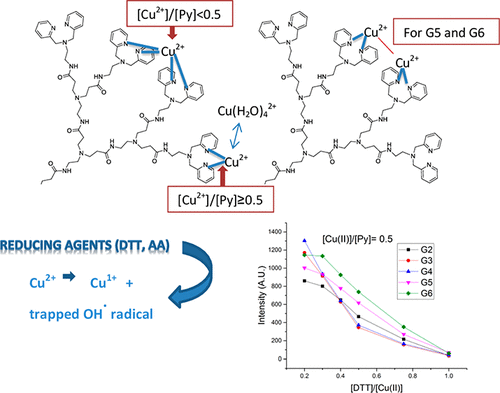当前位置:
X-MOL 学术
›
J. Phys. Chem. B
›
论文详情
Our official English website, www.x-mol.net, welcomes your feedback! (Note: you will need to create a separate account there.)
EPR Characterization of Copper(II) Complexes of PAMAM-Py Dendrimers for Biocatalysis in the Absence and Presence of Reducing Agents and a Spin Trap
The Journal of Physical Chemistry B ( IF 3.3 ) Pub Date : 2017-11-14 00:00:00 , DOI: 10.1021/acs.jpcb.7b09464 Yi-Hsuan Tang,Michela Cangiotti,Chai-Lin Kao,Maria Francesca Ottaviani
The Journal of Physical Chemistry B ( IF 3.3 ) Pub Date : 2017-11-14 00:00:00 , DOI: 10.1021/acs.jpcb.7b09464 Yi-Hsuan Tang,Michela Cangiotti,Chai-Lin Kao,Maria Francesca Ottaviani

|
Polyamidoamine (PAMAM) dendrimers at different generations (from G2 to G6) were functionalized with pyridine (Py) groups at the external surface, and their complexation behavior with Cu(II) at increasing molar ratios between the ions and the Py groups was analyzed in the absence and presence of reducing agents and a spin trap. These Cu(II)–dendrimer complexes may be used as antitumor and antiamyloidogenesis drugs, similarly to other Cu(II)–dendrimer complexes, and as biocatalysts. Indeed, they have revealed to selectively catalyze molecular oxygen reduction to generate reactive oxygen species (ROS). A computer-aided electron paramagnetic resonance (EPR) study of these complexes allowed us to identify different complexes by increasing the Cu(II)/Py molar ratio for the different generations. Binuclear EPR-silent complexes were formed at the highest generations. The differently complexed Cu(II) ions showed a different capability to be reduced, starting from the most exposed at the dendrimer surface bearing a stable Cu(II)–Py2 coordination. Cu(II)–G5 showed peculiar structural properties which probably favored its activity as biocatalyst. The spin trap was able to capture hydroxyl radicals, which became clearly EPR visible after all Cu(II) ions were reduced to Cu(I). This method may be used as a platform to study interactions of Cu(II) in nanosized macromolecules for biomedical purposes, mainly in biocatalysis involving redox reactions and formation of ROS.
中文翻译:

在不存在和存在还原剂和自旋阱的情况下,用于生物催化的PAMAM-Py树枝状大分子的铜(II)配合物的EPR表征
用吡啶(Py)基团在外表面官能化了不同代(从G2到G6)的聚酰胺基(PAMAM)树状大分子,并分析了在离子和Py基团之间摩尔比增加时它们与Cu(II)的络合行为。还原剂和自旋阱的存在与否。这些Cu(II)-树状聚合物络合物可用作抗肿瘤和抗淀粉样蛋白形成药物,与其他Cu(II)-树状聚合物络合物相似,并可用作生物催化剂。实际上,他们已经揭示出选择性催化分子氧还原以产生活性氧(ROS)。对这些配合物的计算机辅助电子顺磁共振(EPR)研究使我们能够通过增加不同世代的Cu(II)/ Py摩尔比来鉴定不同的配合物。双核EPR沉默复合物形成于最高世代。不同络合的Cu(II)离子显示出不同的还原能力,从具有稳定Cu(II)-Py的树枝状聚合物表面最暴露的位置开始2协调。Cu(II)–G5表现出独特的结构特性,这可能有利于其作为生物催化剂的活性。自旋阱能够捕获羟基自由基,在所有Cu(II)离子还原为Cu(I)之后,EPR变得清晰可见。该方法可作为研究生物医学目的纳米级大分子中Cu(II)相互作用的平台,主要用于涉及氧化还原反应和ROS形成的生物催化。
更新日期:2017-11-14
中文翻译:

在不存在和存在还原剂和自旋阱的情况下,用于生物催化的PAMAM-Py树枝状大分子的铜(II)配合物的EPR表征
用吡啶(Py)基团在外表面官能化了不同代(从G2到G6)的聚酰胺基(PAMAM)树状大分子,并分析了在离子和Py基团之间摩尔比增加时它们与Cu(II)的络合行为。还原剂和自旋阱的存在与否。这些Cu(II)-树状聚合物络合物可用作抗肿瘤和抗淀粉样蛋白形成药物,与其他Cu(II)-树状聚合物络合物相似,并可用作生物催化剂。实际上,他们已经揭示出选择性催化分子氧还原以产生活性氧(ROS)。对这些配合物的计算机辅助电子顺磁共振(EPR)研究使我们能够通过增加不同世代的Cu(II)/ Py摩尔比来鉴定不同的配合物。双核EPR沉默复合物形成于最高世代。不同络合的Cu(II)离子显示出不同的还原能力,从具有稳定Cu(II)-Py的树枝状聚合物表面最暴露的位置开始2协调。Cu(II)–G5表现出独特的结构特性,这可能有利于其作为生物催化剂的活性。自旋阱能够捕获羟基自由基,在所有Cu(II)离子还原为Cu(I)之后,EPR变得清晰可见。该方法可作为研究生物医学目的纳米级大分子中Cu(II)相互作用的平台,主要用于涉及氧化还原反应和ROS形成的生物催化。


























 京公网安备 11010802027423号
京公网安备 11010802027423号